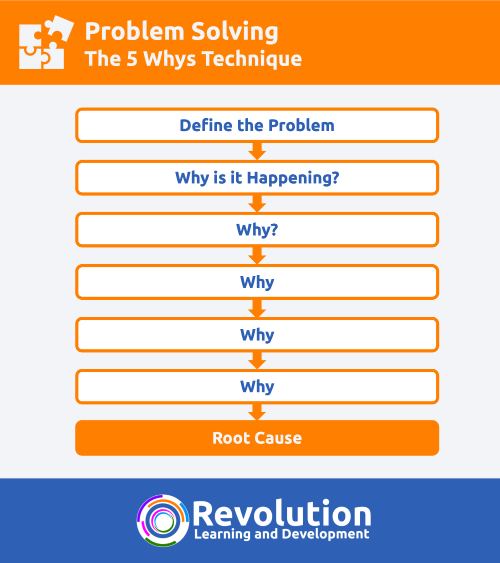Background
The 5 Whys Problem Solving Technique is a question-asking technique used to determine the root cause of a problem. It’s a simple tool to assess a problem and find out what the actual cause of the problem is or was.
The 5 in the title suggests it should take no more than 5 questions to get to the root cause of the problem. The technique works by asking the question ‘why’ 5 times and this should lead you to the root cause of the problem.
Developed by the founder of Toyota Sakichi Toyoda, the 5 Whys Technique is used in problem-solving, troubleshooting and improving processes.
It may not solve the problem by itself but may guide you to an alternative path to follow, for example using a cause and effect diagram (Ishikawa diagram) or another problem-solving tool to fix the problem.
The technique is designed to guide you to the root of the problem.

When To Use the 5 Whys Problem Solving Technique
You can use the 5 Whys Problem Technique when you have a problem or an issue that you need to find the root cause of. It won’t help to actually solve the problem. You can use another method for this, but finding the root cause of the problem will make for better problem-solving.
You may find the technique may not work on a large scale or complex issues and problems. This is because the technique won’t go deep enough in its current design and you may find yourself getting lost in the root cause analysis.
You can use the 5 Why Problem Solving Technique for:
- Quality and process improvement
- Problem-solving and problem analysis
- Problem prevention and future-proofing
How to Use the 5 Whys Problem Solving Technique
Here’s how to use the 5 Whys Technique.
The first stage is to get the team together and clearly define what the problem is you are looking at. It might help to see this taking place live if the issue is currently happening. Then, define and agree on what it should be doing. In other words, what would better look like?
Then, write the problem on a board or paper and start the process described below.
Start with the problem and ask a ‘why’ question about the problem. The next ‘why’ question you ask should then follow on from the answer to the first question. Here’s an example:
The vehicle will not start. (the problem)
- Why? – The battery is dead. (first why)
- Why? – The alternator is not functioning. (second why)
- Why? – The alternator belt has broken. (third why)
- Why? – The alternator belt was well beyond its useful service life and not replaced. (fourth why)
- Why? – The vehicle was not maintained according to the recommended service schedule. (fifth why, a root cause)
You could possibly take this to a 6th or 7th why, but 5 is usually enough to get to the root of the problem.
It’s important to understand that typically the 5th why doesn’t point to a solution – it points to processes. This answer doesn’t tell you how to fix the problem, only what caused it.
What If the Technique Does Not Work?
This is where some other problem-solving tool will come in useful to determine why the root cause existed. So in the above example, the process of servicing the vehicle failed and this is then what needs to be corrected. A cause and effect diagram can then help you to determine which part of the process failed and what corrective actions need to be taken to correct this for the future.
There has been some criticism of the tool in that it’s too basic or doesn’t fix the problem. But when time is short and you need to get to the root cause quickly then the technique is incredibly useful.
Further Learning
If you would like to know more about the 5 Whys Problem Solving Technique and how to use it in your day to day work, our Critical Thinking and Problem Solving Training Course will provide you with some help and guidance on this.
References
The 5 Whys Example above is taken from Wikipedia



